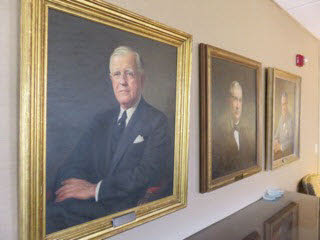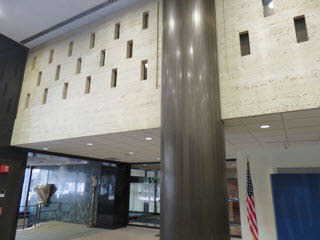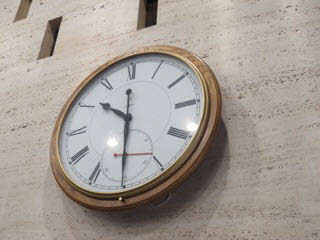
The former American National Bank building
photo by John Shearer

Downtown SunTrust Bank building features parking garage
photo by John Shearer

Ben Probasco in front of bank
photo by John Shearer

American National’s gear logo remains
photo by John Shearer

Portrait of Scott “Scotty” Probasco Jr.
photo by John Shearer

Painting of former American chairman Sam Yarnell
photo by John Shearer

Portrait of Scott Probasco Sr.
photo by John Shearer

Early American director E.Y. Chapin Sr.
photo by John Shearer

Early American bank director Harry Scott Probasco
photo by John Shearer

Old former bank boardroom on 13th floor
photo by John Shearer

American directors when former bank building enlarged
photo by John Shearer

Directors on American’s 50th anniversary
photo by John Shearer

Vintage-style mail dropbox
photo by John Shearer

SunTrust regional president J.V. Vaughn
photo by John Shearer

Mid-century style rectangular windows on mezzanine floor
photo by John Shearer

The bank’s lobby in 2018
photo by John Shearer

Old-style clock in downtown SunTrust lobby
photo by John Shearer

Mementoes from 1968 bank opening
photo by John Shearer

Gerry and Estes Stephens
photo by John Shearer
One of Chattanooga’s longtime depositors and loaners of money has collected its own form of gold this year.
The 20-story SunTrust Bank building downtown – originally built as the locally based American National Bank’s headquarters -- is reaching its golden anniversary with its 50th birthday.
In the early fall of 1968, the structure opened at Market and Eighth streets amid much fanfare.
“It was like a carnival atmosphere,” recalled Ben Probasco, now a partner with Kinsey Probasco Hays development firm and then a Bright School student and youngest child of bank executive Scotty Probasco.
“I’d never seen anything like it.”
“This was more fun than banking,” recalled Gerry Stephens, who was already a vice president then and was asked by president John Wright to help coordinate the opening. “I enjoyed it.”
Besides the excitement of the opening of a bank that was prominent on the local financial scene at the time, the building’s opening was also significant historically. The reason was that it was eclipsing the then-Hamilton National Bank (now First Tennessee) as the tallest building in Chattanooga.
According to Mr. Stephens, who now lives in retirement in Riverview, the bank had been a project of Mr. Wright and came about in part because of parking issues for employees and customers.
A handsome-but-smaller bank building designed by noted Chicago-based and German-born architect Karl Vitzthum, whose specialty included banks, had stood at the site since 1928.
So the most practical alternative was to build a new bank, and plans for it were underway by 1966. It would include a large parking garage wing as part of it, since parking has historically been an added amenity for workers in downtown Chattanooga.
Alfred Easton Poor of New York City was chosen to be the lead architect, with James R. Franklin of Chattanooga serving as the associate architect. The general contractor was the Henry C. Beck company of Dallas/Atlanta.
Mr. Poor at the time the building opened was nearing 70. The World War I Navy veteran and University of Pennsylvania architecture school graduate designed such well-known buildings as the Jacob K. Javits Federal Building in Manhattan, the James Madison Memorial Building at the U.S. Library of Congress in Washington, D.C., and the Wright Brothers National Memorial on the coast of North Carolina.
Before his death in 1988 at the age of 88, he also designed a number of country homes on Long Island as well as buildings for the Chemical, National City and Marine Midland banks. The latter must have been how he got on the radar of American National Bank.
American National Bank showed early on that it had a New York attitude of success by deciding in 1966 to make the bank building two stories taller than originally planned.
Part of the reason was that the old Hamilton National Bank, which became First Tennessee in the 1970s but had been Chattanooga’s tallest building since before World War I, was also doing some expanding. That came about as it added its metallic sheath on the outside, a trend popular at the time.
Another aspect of the American National Bank’s development about this time was that it had adopted a new logo to replace its American eagle. The new symbol was a gear wheel with eight A’s in a circle, meant to symbolize in part Chattanooga’s industrial growth over the years.
The eight A’s – which started with the same letter as did American National Bank – stood for alert, available, amiable, active, acumen, adaptable, assurance and able. These were intended as qualities to which the bank and its employees should aspire.
Ben Probasco remembered with a laugh that his father would sometimes try to mention them on the spur of the moment and could remember about four but would not be able to get through all of them.
While not picked up by SunTrust Bank as a motto or mission statement after the merger, the gear symbol is still apparent visibly. Because a giant circular gear design of the eight A’s was built into the side of the building facing the Tennessee River, they are still there.
Mr. Stephens believes it was too difficult to remove them.
In April of 1966 – in between the unveiling of the insignia and the decision to make the American bank taller – the safe deposit boxes of the old bank were removed to allow for the demolition and new construction. They were moved a short distance to the Chattanooga Bank Building, which had once housed a banking institution that eventually merged with American National.
The boxes were moved a few sections at a time via a forklift. While only a few people were required physically for such work, many others were needed in terms of security. That included about two bank guards, three Wells Fargo guards and six city police officers. A Wells Fargo armored truck also followed.
The customer service aspect of the facility had moved to the W.T. Grant Building at 715 Market St.
Ground breaking for the new bank was held on July 7, 1966, and the topping-out ceremony of the new building using a gilded steel beam was held on Feb. 6, 1968.
As the construction moved upward, what was described as the largest crane in the South had to be used. It was being leased from Atlanta.
Mr. Stephens’ wife, Estes, remembered that, during some special occasion while the crane was used, they and their three young children took some hot chocolate and went to look at it one cold morning.
Mr. Stephens also remembers that the Rotary Club of Chattanooga had its weekly meeting once on the eighth floor of the under-construction – and open-air -- building.
Architecturally, the building was to have straight lines typical of that time period, but also was to feature unique mid-century adornments.
That included precast concrete panels that now give the building its white look, sleek bronze anodized windows, and some inside rectangular windows that allow people in the mezzanine level to see the lobby below.
There was also a walk-through corridor from Cherry Street to Market Street, which was helpful during wet weather. If snow or ice was on the ground, the building had its Sno-Melter cables under the outside sidewalks and plaza to melt it.
One old-fashioned – but popular -- feature the building was to have was a cafeteria on the 18th floor and some smaller dining rooms for private meetings. The cafeteria manager became Del Good, whose food drew compliments.
As the building was nearing completion, the trust department of the bank moved into the new building on Sept. 9, 1968, and the whole structure opened for business on Monday, Sept. 23, 1968.
Its official -- and memorable -- opening was on Oct. 14, 1968. Mr. Stephens recalled that one part of the ceremonies was a series of drawings to give attendees the interest on a million dollars over one or several days.
“We would look at what the Dow (Jones) would end on that day and pay the person the interest on what a million dollars was,” said Mr. Stephens.
The younger Mr. Probasco – who initially feared he might have to miss the opening ceremonies due to a scheduled swim practice – said that perhaps the most memorable aspect to him was a robot-like character that entertained.
“Nobody ever really knew if it was a person in a costume or a real robot,” he said. “It was like something out of ‘Star Trek.’ ”
Mr. Stephens said he learned about the robot act from pastor Ben Haden of First Presbyterian Church, who met the participant or participants on a flight. The bank ended up paying $10,000 for the act, Mr. Stephens recalled.
An old newspaper article from 1968 called the act a robot named “Golden Girl,” and said it had been featured at the HemisFair ’68 world’s fair in San Antonio. It was evidently at the bank for several days.
Mrs. Stephens seemed to remember two women who were behind a booth and worked with the act.
Since Mr. Stephens was involved in the opening, he has kept for years -- and given away -- various mementoes of the ceremonies, including small replica coin banks of the then-new building.
Mr. Probasco – who recently reminisced about the opening ceremonies in front of the bank just below the window where his late father’s second-floor office was -- said he and his three siblings still have the coin banks. He also still has his small collection of three or four playing cards from the opening, and demonstrated a trick in which the card someone thinks he or she is picking comes out as a card with the American National Bank logo on it.
Also part of the 1968 opening were tours by uniformed girl guides throughout the week.
A magazine-type book the bank later put out about the opening said that Mayor Ralph Kelley, County Judge Chester Frost, retired pastor Dr. James Fowle of First Presbyterian Church and bank building committee chairman Hardwick Caldwell led the opening ceremonies. Mr. Stephens recalled that Mr. Haden was supposed to have taken part but was running late getting back from an out-of-town appointment.
Since “Youth in Action” was the theme of the ceremonies, students Harold Haggard of the University of Chattanooga and Steve Sligh of Covenent College cut the ribbon opening the building, and high school students also took part.
The event – which began outside the building and culminated with activities inside the lobby and elsewhere -- was called the largest downtown street crowd in modern history.
The building’s opening ceremonies and construction eventually gave way to other memorable events and other buildings in downtown Chattanooga – including the taller Commerce Union building (later Republic Centre) that opened in the 1970s.
And American National Bank would eventually become SunTrust Bank, and the bank would need fewer floors in the building than American National once did. Today, the building is owned by the Simpson Property Group of Atlanta, and a giant old-style clock in the lobby reveals that time has moved on.
But memories of the connections to American National Bank – and the cheerleader-like bank executive Scotty Probasco -- still remain.
Current SunTrust East Tennessee region president Jim “J.V.” Vaughn recently gave a tour of the building and pointed out a number of pictures of the old American National Bank directors, portraits of the Probasco family and Sam Yarnell, and the old 13th floor board room.
After finishing the tour, he said he knew what Mr. Probasco would say about the bank turning 50 years old this year. “He would say, ‘Great Work,” Mr. Vaughn said with a laugh, referencing the trademark line of the enthusiastic Chattanoogan, whose business philosophy was “hold what you got and go get more.”
Mr. Vaughn also believes the building has been an important asset to Chattanooga over the last 50 years. “I think it’s been a great historic cornerstone of Chattanooga’s history and continues to showcase the progress that’s going on throughout the great city,” he said.
Jcshearer2@comcast.net